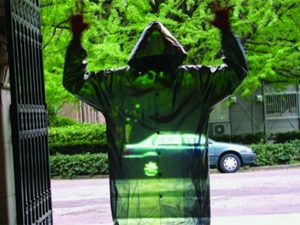



Date:14/03/16
 Iowa State University engineers have created a flexible, tunable “meta-skin,” a material that uses rows of liquid-metal devices to cloak an object from radar detection.
Iowa State University engineers have created a flexible, tunable “meta-skin,” a material that uses rows of liquid-metal devices to cloak an object from radar detection.
The skin gets its names from metamaterials, a family of composite materials that have the ability to manipulate electromagnetic waves. By stretching or flexing the polymeric meta-skin, the way it interacts with such waves changes, allowing it to reduce reflection of a wide range of radar frequencies. This allows it to cloak objects from radar detection.
Lead authors of the paper are Associate Professor Liang Dong, with a background in micro and nanoscale device fabrication as well as liquid and polymer studies and Professor Jiming Song, who is researching new applications for electromagnetic waves. Together, they wanted to prove that electromagnetic waves can be suppressed with flexible, tunable materials that incorporate liquid-metal technologies.
Their finished product is made up of rows of split ring-like resonating structures, fixed by layers of silicone sheets. The resonators have a 2.5mm radius and a thickness of half a millimeter, with a 1mm-wide gap between them. They’re filled with galinstan, a metal alloy that remains liquid at room temperatures and is less toxic than metals who share this property, such as mercury.
The rings function as electric inductors and the gaps between them create electric capacitors. Together they form a resonator that can trap and suppress radar waves of a certain frequency. Stretching the meta-skin alters the size and shape of the liquid metal rings inside and changes this frequency, allowing for a wide range of signals to be absorbed.
Testing showed that the material can suppress 75% of radar signals in the 8 to 10 gigahertz frequency range. If wrapped in the meta-skin, the radar waves “are suppressed in all incident directions and observation angles,” according to the paper.
One of the most obvious uses of the meta-skin is in military technology. As he discussed the meta-skin, Song also mentioned the B-2 stealth bomber. One day, he said, the meta-skin could coat the surface of the next generation of stealth aircraft. But the researchers are setting their sights even further – a cloak of invisibility.
Meta-skin could lead to invisibility cloak
 Iowa State University engineers have created a flexible, tunable “meta-skin,” a material that uses rows of liquid-metal devices to cloak an object from radar detection.
Iowa State University engineers have created a flexible, tunable “meta-skin,” a material that uses rows of liquid-metal devices to cloak an object from radar detection.The skin gets its names from metamaterials, a family of composite materials that have the ability to manipulate electromagnetic waves. By stretching or flexing the polymeric meta-skin, the way it interacts with such waves changes, allowing it to reduce reflection of a wide range of radar frequencies. This allows it to cloak objects from radar detection.
Lead authors of the paper are Associate Professor Liang Dong, with a background in micro and nanoscale device fabrication as well as liquid and polymer studies and Professor Jiming Song, who is researching new applications for electromagnetic waves. Together, they wanted to prove that electromagnetic waves can be suppressed with flexible, tunable materials that incorporate liquid-metal technologies.
Their finished product is made up of rows of split ring-like resonating structures, fixed by layers of silicone sheets. The resonators have a 2.5mm radius and a thickness of half a millimeter, with a 1mm-wide gap between them. They’re filled with galinstan, a metal alloy that remains liquid at room temperatures and is less toxic than metals who share this property, such as mercury.
The rings function as electric inductors and the gaps between them create electric capacitors. Together they form a resonator that can trap and suppress radar waves of a certain frequency. Stretching the meta-skin alters the size and shape of the liquid metal rings inside and changes this frequency, allowing for a wide range of signals to be absorbed.
Testing showed that the material can suppress 75% of radar signals in the 8 to 10 gigahertz frequency range. If wrapped in the meta-skin, the radar waves “are suppressed in all incident directions and observation angles,” according to the paper.
One of the most obvious uses of the meta-skin is in military technology. As he discussed the meta-skin, Song also mentioned the B-2 stealth bomber. One day, he said, the meta-skin could coat the surface of the next generation of stealth aircraft. But the researchers are setting their sights even further – a cloak of invisibility.
Views: 799
©ictnews.az. All rights reserved.Similar news
- The mobile sector continues its lead
- Facebook counted 600 million active users
- Cell phone testing laboratory is planned to be built in Azerbaijan
- Tablets and riders outfitted quickly with 3G/4G modems
- The number of digital TV channels will double to 24 units
- Tax proposal in China gets massive online feedback
- Malaysia to implement biometric system at all entry points
- Korea to build Green Technology Centre
- Cisco Poised to Help China Keep an Eye on Its Citizens
- 3G speed in Azerbaijan is higher than in UK
- Government of Canada Announces Investment in Green Innovation for Canada
- Electric cars in Azerbaijan
- Dominican Republic Govt Issues Cashless Benefits
- Spain raises €1.65bn from spectrum auction
- Camden Council boosts mobile security





















